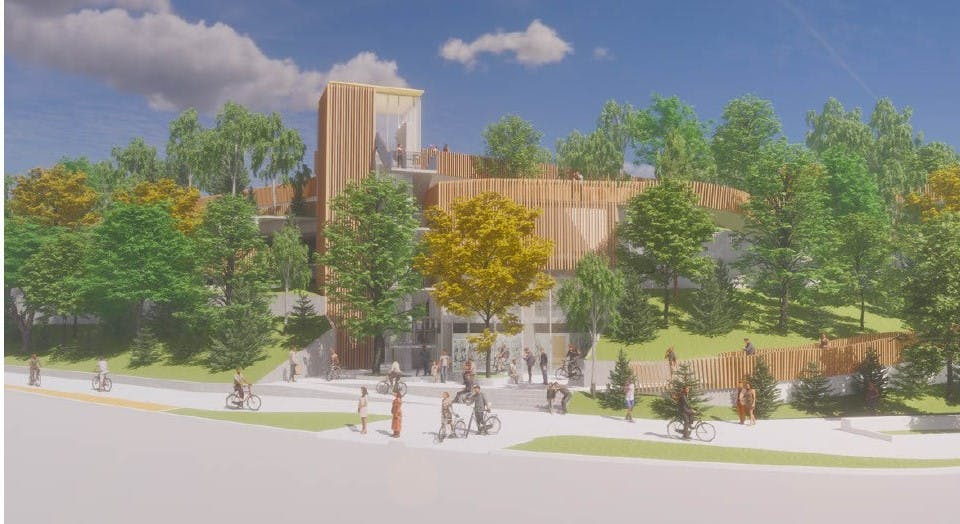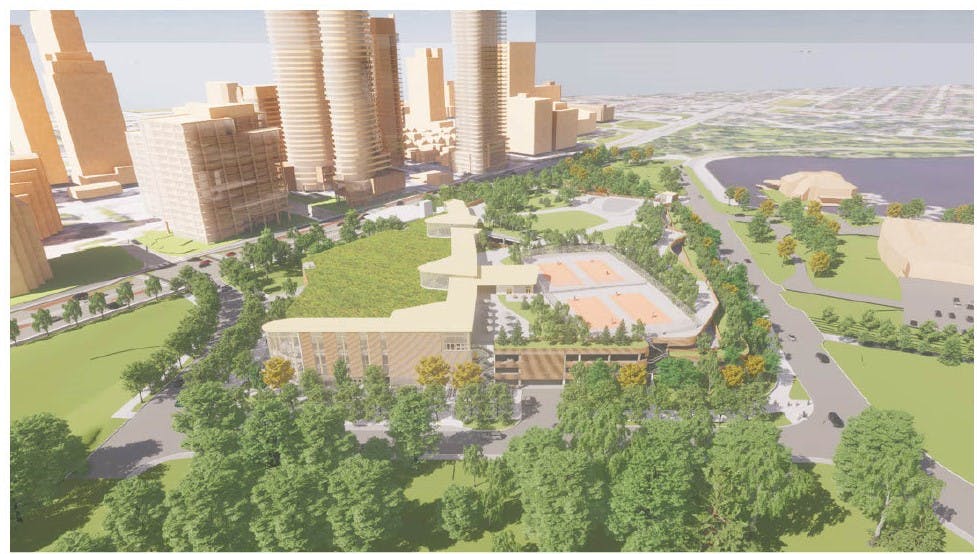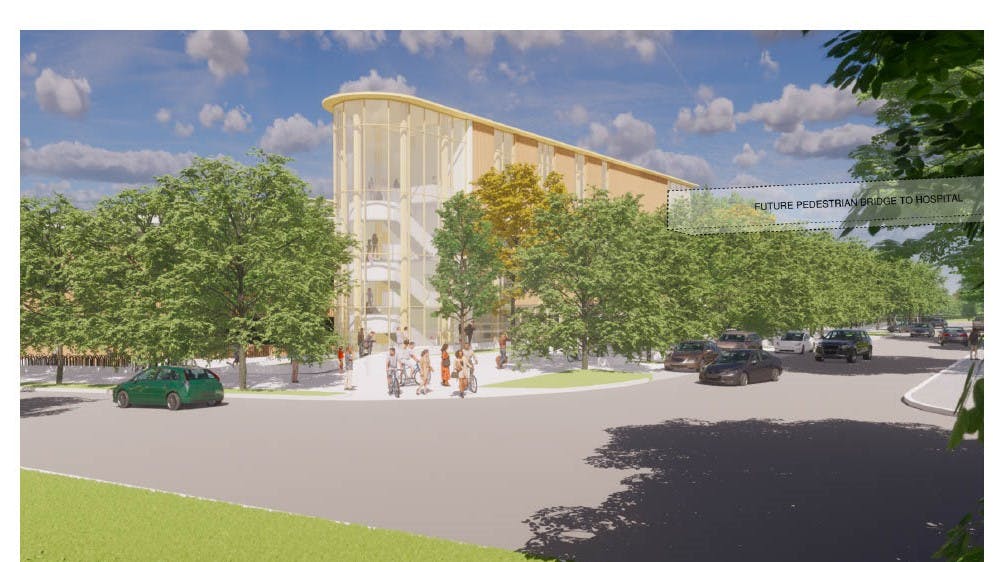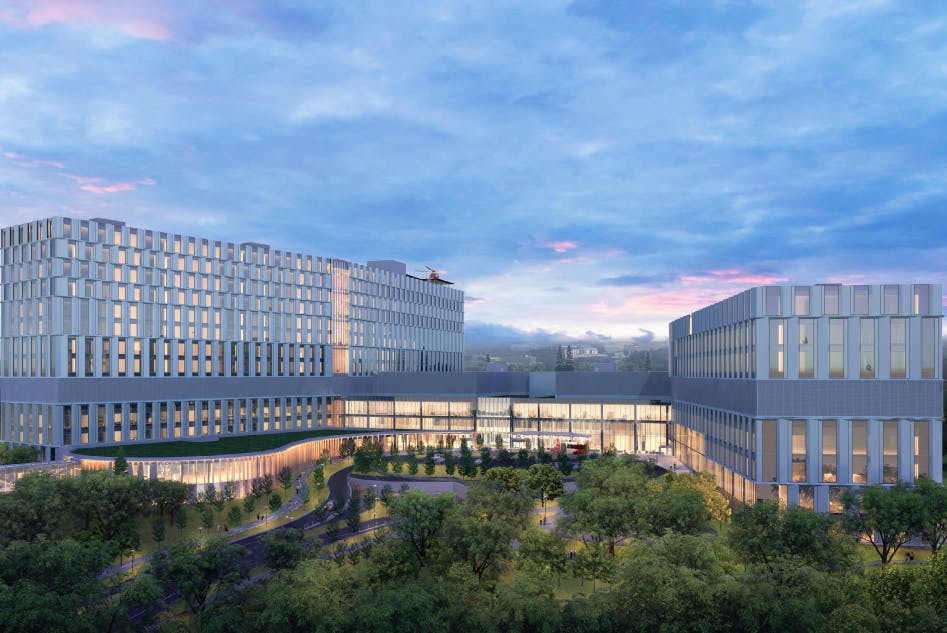The Ottawa Hospital Master Plan
The Ottawa Hospital’s new Civic campus development, which will be located on Carling Avenue adjacent to Dow’s Lake, will be the major referral centre for Eastern Ontario, Western Quebec and parts of Nunavut, and the Eastern Ontario Trauma Centre. As one of Canada’s largest acute care learning and research hospitals, the new campus will provide a full range of specialized services, research and education for those with the most complex injuries and illness.
Background of the hospital project
- 2007 - the Ottawa Hospital convened a Steering Committee to develop a Master Plan which concluded the current Civic Campus is too old and would be too difficult and costly to rebuild.
- 2009 to 2013 - the Ottawa Hospital was in discussions with the Government of Canada related to master planning for a new Ottawa Hospital campus and land requirements.
- 2014 - the Government of Canada commissioned the National Capital Commission to assist in the land transfer process to the Ottawa Hospital .
- December 2015 - the federal government requested a further review of the land options for the new campus and four sites were examined
- May 2016 to November 2016 – NCC Public Consultation and Site Selection
- December 2016 - Canadian Heritage requested that the Federal government make the Sir John Carling site available as the future location of the new campus of the Ottawa Hospital .
- May 2017 - the City’s Planning Committee recommended that staff initiate Official Plan and Zoning By-law amendment applications for this federal land use decision.
- September 2017 to January 2018 – public engagement strategy with nine open houses
- December 2017 and March 2018 – design sessions with the Urban Design Review Panel
- February 2018 - Public Services and Procurement Canada announced a 99-year lease between the Federal Government and The Ottawa Hospital for the development of a new campus.
- May to June 2018 – Official Plan and Zoning By-law amendments approved by Planning Committee and City Council through By-law 2018-198 to a new Institutional I2 Zone
Proposal master site plan
The proposed hospital site is located at 930 and 850 Carling Avenue and 520 Preston Street. The site is approximately 21 hectares in size within Ward 16 and adjacent to Wards 14, 15, and 17 (see Figure 1).
The site is irregularly shaped and bound by Carling Avenue to the north, Prince of Wales Drive and Preston Street to the east and is loosely bound by the National Capital Commission Scenic Driveway to the south and Maple Drive to the east. The Trillium line (O-Train line) bisects the eastern part of the site.
The primary access for staff and visitors is off both Carling Avenue (across from Champagne Ave) and Prince of Wales Drive, accessing the new 4 storey parking structure.
The main hospital, which is located on the top of the escarpment, will be constructed after the parking structure and once services and utilities are established. The New Hospital Building includes a Central Podium, which will be two storeys, supporting the 2.5 million square feet of hospital space. The Central Podium has two entrance points. Visitors and patients will primarily access the hospital from the parking garage, rapid transit along Carling Avenue and the Carling LRT Station, with access via a pedestrian bridge from the parking facility to the main hospital building. A covered Emergency Department ambulatory drop-off will also be available on the east side of the building for visitor and patient access. First responders and ambulance transfer services, including the ambulance garage, will access the hospital from auxiliary entrances facing west.
Two patient care towers will flank the Central Podium, with the South Tower intended to be 12 storeys and will include a Helipad on the 12th floor, and the North Tower intended to be eight storeys. The proposed eight-storey North Tower is anticipated to be expanded vertically in future phases. The Main Plaza will connect the Central Podium to the entrance from Champage Avenue and Carling Avenue, providing vehicular, pedestrian and transit-user access to the main entrance.
Building Twenty-first-century health care in the heart of the nation’s capital
Due to the size of the project, the new Ottawa Hospital will be completed in phases. The Master Plan currently outlines 10 phases.
2021: Master Site Plan approvals
2022-2023: Parking garage
2024-2026: New Hospital Central Utility Plant
2024-2028: New hospital
TBD: Potential LRT Station expansion
2024-2029: Research Tower
2029-2039:
- Carling Tower A
- Carling Tower B
- Carling Tower C
2024-2028: Rehabilitation Unit
2035-2038: New Hospital expansion
2045-2048: University of Ottawa Heart Institute expansion
Key decision points
- October 1, 2021 – Master Plan approval by Joint Built Heritage Sub Committee and Planning Committee
- October 5, 2021 – Master Plan approved by NCC Board
- October 27, 2021 – Master Plan approved by City Staff
- November 5, 2021 – Urban Design Review Panel review
- November 26, 2021 – Advisory Committee Planning Design Realty review
- January 20, 2022 – Phase 2 parking garage schematic design approved by NCC Board
- February 10, 2022 – Phase 2 parking garage endorsed by Planning Committee
- March 15, 2022- Federal Land Use Design approval granted to enable early works
- May 10, 2022 – Final Phase 2 parking garage Urban Design Review Panel review
- September 27, 2022 – Phase 2 parking garage approved by City staff
- May 21, 2024 – Phase 3 and 4 Site Plan Control approved by City staff
Previous approvals
- Master Site Plan approval
- Phase 2 Site Plan approval (parking garage)
- Planning Committee Master Plan Approval meeting minutes
- Planning Committee parking garage approval meeting minutes
- Phase 3 (Central Utility Plant) and Phase 4 (Main hospital building) Site Plan Control approval
Phase 3 and 4 Site Plan Control Application
The subject application is both the third and fourth phase of the Master Site Plan consisting of a Central Utility Plant with electrical, heating and cooling equipment (Phase 3) and the main Hospital building (Phase 4). The main Hospital building will consist of approximately 230,000 square metres of gross floor area comprising a two-storey podium, two towers (Towers A and B) which will house the majority of the patient rooms, and a Pavilion flanking the Main Entrance. The Pavillion will consist of meeting and conference rooms, an auditorium, retail spaces, a cafeteria, and will connect to the weather-protected highline pathway across the top of the four storey parking garage.
Tower ‘A’ is eight storey’s and closest to Carling Avenue and the Dominion Observatory Complex. Tower ‘B’ is twelve storeys and is located south of Tower ‘A’.
Phase 3 and 4 will also consists of landscape improvements to enhance accesses to the Hospital and will complete the construction of separated pedestrian and cycling facilities through the site on the east side of internal Roads A and B. It will also complete a multi-use pathway on the south side of the main entrance and a sidewalk on the north side to provide access to the main entrance. The relocation of existing services located within the site and offsite intersection improvements will be necessary to enable these phases.
Timelines
Important dates include:
- September 20, 2022 Accessibility Advisory Committee meeting held
- November 15, 2022 Pre-consultation with Local Community Associations held
- Q4 2022 Phase 3 and 4 Site Plan submission to the City
- Q1 2023 City’s Urban Design Review Panel Review;
- Q1-Q2 2023, Public Information Meeting, Review and Issue Resolution
- Q2 2023 NCC Advisory Committee on Planning, Design and Realty
National Capital Commission involvement
- Requires an NCC Federal Land Use and Design Approval granted under the National Capital Act by the NCC
- NCC review is guided by Project Specific Performance Criteria including integration, design excellence and sustainability
- Schematic Design to be reviewed against Federal legislation and plans, including NCC’s Plan for Canada’s Capital and the Capital Urban Lands Plan
- Will be reviewed by NCC’s Advisory Committee on Planning, Design and Realty
- Application requirements include reporting on public engagement
- Subject to NCC’s review and issue resolution – Board Approval
Stay informed and involved
- Register for future notifications about this site plan control application by providing your comments by e-mailing Stream Shen and adding File No. D07-12-22-0168 in the subject line.
- Access submitted plans and studies regarding this application online at ottawa.ca/devapps.









Room to grow?
One need only look at the long history of our current Civic Hospital to appreciate just how much such a world-class hospital facility grows over time. To where, exactly, will the new Ottawa Hospital expand in the future? By further incursion into the Central Experimental Farm? A move across Prince of Wales Drive into the Dominion Arboretum? Or across Preston Street into Commissioners’ Park? Maybe a new Dows Lake Pavilion? The fact is there is no room to grow in the proposed location without the loss of more accessible green space, historic sites and/or tourist attractions . What are the plans in that regard?
This comment says it all so I'm pasting it in again.
How does the mulching of 680 trees, many of which are 50 plus years old, on the proposed site align with the City's Climate Action plan? When you take the loss of these trees along with the 4 acres of Red Pine at Hunt Club that the city plans to turn into a parking lot and the loss of the woods at the new Embassy Row, the combined loss is unfathomable. We need strong action to save what little greenery Ottawa has left after suffering huge canopy loss as a result of Ash Borer. As the temperatures globally go up, our natural environment is even more needed to combat heat waves, flooding and overall biodiversity loss. It's time for strong leadership!
dmp123 20 days ago
The hospital should be located at the Carling location an area zoned as institutional not park.
P.S Tunneys, is not the original location, that was across the street from the current site, and that would be my second choice.
Is the city concerned about mixing tourist/neighbourhood pedestrian/cyclist traffic - those who are visiting our National Historic Buildings - with emergency vehicles on Maple Drive. Does the city think having emergency vehicles and the Central Utility Plant on Maple Drive will negatively impact the experience of visitors to our National Historic site?
1 - Why was Tunney's Pasture, the original recommendation, rejected in favour of destroying park land?
2 - Why is there so much sprawl? This is an urban hospital being built on greenspace - I don't understand why it would have to be 50 acres of spread-out, relatively short buildings, especially on prime park space in the middle of the city? It seems like the aesthetics and car-centrism of the design is being favoured over environmental or practical concerns.
The hospital should be located at the Tunney Pasture site. It’s on transit, and is already a good location for a new building while the Dow’s Lake site is a walk from transit and will take away valuable green space and trees that give relief from heat and pollution caused by the climate emergency. Rethink the location. Do not put so much emphasis on car traffic. The thought of a 4 storey parking garage replacing a park is shocking at this time when the City is urging us all to use active transportation.
Has the prospect of acquiring the parking lot at Hickory, Champagne, and Carling been explored? This seems like it could be a better place to expand parking for the new hospital than the Dow's Lake lot, where I'm concerned the planned parking structure will negatively impact the experience of visiting Dow's Lake and the surrounding parkland. The site at Hickory, Champagne, and Carling could, I imagine, include significant underground and overground parking, and it could be connected to the hospital by a pedestrian overpass or tunnel (or both) to ensure a safe and convenient way for people to cross Carling.
How will this development affect the Trillium Pathway (not mentioned in the second paragraph of the Proposal section on this webpage, I can't help noticing)? Rerouting the pathway from the current Carling Station along the perimeter of the hospital to the corner of Queen Elizabeth and Preston would be fine, as long as there is in fact a wide, lit, dedicated route for cyclists. This could also be an opportunity to improve the Queen Elizabeth-Preston intersection to make it more cycle-friendly.
It makes NO sense to require people coming to a hospital to walk through a long enclosed overpass from the LRT!
Why does your “background history” completely skip the original recommendation of Tunney’s Pasture as the new hospital site? Why didn’t that site get used, it’s already developed, flat, has no earthquake fault, and has transit as well as multiple accesses??! Most importantly, it is NOT a heritage site complete with urgently needed green infrastructure, e.g., mature trees!!
We have to stop losing valuable green space to parking lots. Next generations deserve better decisions now. I’m glad designers have considered creating a green space on the parking garage roof but even better would be to have parking underground with a tunnel to the hospital.
Removed by moderator.
Removed by moderator.
Removed by moderator.
Removed by moderator.
Removed by moderator.
Why are you removing the South end of the bike path from the Ottawa River to Dow's lake? We need MORE active transportation facilities, not less.
Where is the bike parking, for staff, for visitors, for patients?
Why such a HUGE parking lot when the hospital is on the transitway? Cars pollute and waste energy compared to transit and bikes. Bikes are also much healthier.
Could you please provide more information on the cycling facilities on campus. (The existing documents describe cycling around the perimeter of the site, but not on the site itself).
Specifically:
- are the pathways in the Queen Juliana Park multi-use or pedestrian only? Will it be possible to cycle right up to the main buildings?
- what is the plan for biking parking? Does this include some SECURE bike parking?
Many thanks in advance.
How can the indigenous trail from Dow's Lake along Sherwood Drive to Remic Rapids be integrated into the plan?
Using Maple Drive as emergency access: Why turn Maple Drive, the main entrance to the Experimental Farm, into an ambulance route instead of keeping the ambulances on Carling, where they already are for the current Civic campus? The noise from ambulances having to turn off Carling into the Farm will be a nuisance to residential neighbours. Alternatively, having ambulances enter the hospital campus directly from Carling nearer Preston (largely commercial), as they do now directly from Carling near Melrose, would not require turning a tree-lined drive into a hospital service entrance. Plans also show that Maple Drive will be fronted by noisy air, heating, and other industrial requisites; this seems a gratuitous reason for destroying old-growth trees--can these utilities not be sited elsewhere?